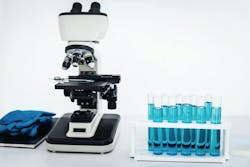How Advanced Heat Transfer Techniques Are Revolutionizing Lab Equipment Design
Devices used in laboratories, hospitals and similarly high-demand settings must remain consistently accurate to encourage trust in the parties using them for critical tasks. However, overheating can cause premature failures or incorrect results.
Designers engineer carefully chosen components such as heat sinks, fans and liquid cooling mechanisms to keep products at safe and effective operating temperatures. Understanding the correct heat transfer techniques for individual applications allows them to create offerings that safeguard brands’ reputations and achieve significant adoption rates.
Many teams use artificial intelligence to plan innovations and build working prototypes. Similarly, they deploy digital twins to mimic how people will use the items in real life. Simulating those scenarios lets engineers pinpoint potential issues that could cause the devices to get too warm and malfunction. How have professionals managed common challenges with AI in lab equipment design and advanced medical devices?
Using Generative AI in Lab Equipment Design for Process Improvements
Generative AI has become mainstream, primarily in chatbot interfaces that respond to user prompts. Some industrial leaders see other opportunities, especially for applying the technology to process improvement goals.
In one example, a life sciences company used generative AI to identify historical process deviations and suggest steps to correct and prevent these issues. Statistics indicated up to 20% of these events recur because of ineffective remediation efforts. This business relied on AI to synthesize 70% of cases and link them to similar instances. Additionally, the tool proposed interventions to stop or fix 80% of those shortcomings in the first drafts of its guidance.
Lab equipment design teams may take inspiration from this experiment and develop practical ways to accelerate their workflows through purposeful problem-solving. For example, the AI application automated the relevant documentation by populating report fields with the correct content.
READ MORE: Adaptive Design in Machinery: How AI is Enabling Custom Production Solutions for 2024
Imagine if repeated tests showed a piece of lab equipment frequently overheated and gave misleading results. Artificial intelligence could assist participants in brainstorming strategies to overcome the challenge through forward-thinking heat transfer techniques.
It may also raise productivity by reducing manual procedures. Then, instead of filling out paperwork, engineers can proofread the materials to ensure correctness before submitting the evidence to the appropriate parties. These thoughtful, tech-driven tweaks allow professionals to spend more of their workdays addressing known problems and shorten the time required to compile the associated documents.
Artificial intelligence might also improve standardization among design groups, helping everyone involved get the necessary information and act on it to troubleshoot the affected products.
Identifying Which Activities Need Human Oversight
As decision-makers explore the most feasible ways to apply AI in lab equipment design, they should examine case studies in adjacent industries and learn which processes to automate versus supplement with employee supervision. One study examining the potential automation of heat-induced epitope retrieval assessed slides at several intervals to determine the minimum threshold for acceptable staining quality.
When comparing the automated system with the traditional pressure cooker method, the results showed that three-quarters of the slides linked to the automation-driven method scored lower than or matched the conventional ones. Additionally, 50% of the slides in that batch had scores below those from the pressure cooker approach, even at retrieval times up to 90 min.
Although professionals interested in using AI in lab equipment design should not consider this example as a reason to discard the technology, they will get the best results by understanding how the technology excels and where it falls short. Instances in the second category may highlight the activities requiring supervision or additional checks.
READ MORE: AI Can Reason, and the Medical Devices Industry has a Reason for AI
Many impactful potential applications combine humans’ specialized expertise with advanced algorithms. One case applicable to lab equipment and medical device designs involved a group using AI to find new thermal insulators, which can make products more energy-efficient or regulate operating temperatures. The technology suggested over 50 thermally insulated materials matching their desired properties.
The AI tool’s developers focused on thermoelectric elements, which convert waste heat into electrical power. Those outcomes could advance designs and allow engineers to include components that generate energy from excess warmth, making solutions less dependent on batteries.
Then, internal medical devices or innovations requiring otherwise cumbersome battery changes could become increasingly convenient for the medical practitioners and patients relying on these potentially life-altering products.
Applying AI in Medical Device Design for Better Applicability
Some AI-enabled manufacturing products adapt to workers or processes, saving time and making the technology relevant to diverse needs. Designers working on the latest medical devices could take the same approach by building their products to meet the requirements of specific groups or even individual people.
One team used a digital twin to identify a particular protein to target when developing allergy-relief medications. Their efforts indicated that inhibiting it increased effectiveness compared to targeting a different one commonly addressed by other medicines. These findings illustrate how seemingly minor tweaks can substantially impact overall outcomes.
Digital twins empower lab equipment modifications, too. They allow users to test numerous versions in simulated but highly realistic environments, revealing which areas to focus on while studying heat transfer techniques or additional aspects essential to good performance. Results from those controlled environments guide design enhancements in physical products to save companies time and money while furthering continuous improvements and competitive advantage.
READ MORE: Integrating AI into Medical Devices and Applications
Researchers also explored digital twin potential on a massive scale by creating more than 3,800 anatomically correct models of human hearts. These resources confirmed how factors like age and obesity affect electrical properties. They highlighted that gender-related differences in ECG reading occur because of heart size differences instead of electrical conductivity variations, too.
These takeaways could encourage designers to develop medical devices that work better than leading commercially available options, helping their employers increase brand dominance in crowded marketplaces and boost their bottom lines.
Rather than designing for the masses, some businesses could fulfill niches by capitalizing on personalized medicine, delivering patient-specific products. Artificial intelligence-powered digital twins enable these and other advancements that keep manufacturers in demand. Investments to support AI in medical device design keep producers future-ready and adaptable.
Succeeding With Laboratory Equipment Improvements and AI in Medical Device Design
Artificial intelligence can reveal new heat transfer and thermal management techniques that stabilize the performance of forthcoming medical devices and laboratory equipment models. Understanding applicable real-world examples is the first step in finding useful ways to incorporate the technology into workflows, relieve process burdens and tackle challenges.
About the Author

Emily Newton
Emily Newton is a technology and industrial journalist. She is also the editor in chief of Revolutionized. She has over five years covering stories about warehousing, logistics and distribution.
